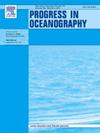Evaluating the performance of an ensemble forecast system in predicting Loop Current Eddy separation in the Gulf of Mexico
IF 3.6
3区 地球科学
Q1 OCEANOGRAPHY
引用次数: 0
Abstract
Forecasting mesoscale variability, such as the Loop Current (LC) growth and Loop Current Eddy (LCE) shedding in the Gulf of Mexico, poses challenges due to the large uncertainty in initial conditions and the development of non-linear instabilities from LC-cyclone interactions, which are crucial for LC/LCE separation. An ensemble forecast system may account for this uncertainty and filter out unconstrained scales and thereby extend the predictability of the mesoscale variability. A 32-member ensemble forecast system is employed to investigate the predictability of LC/LCE separation, with a specific focus on the December 2019 – March 2020 period. The forecasts demonstrated predictability of LC/LCE separation out to 7 to 13 weeks. During this period, significant changes occurred in the LC. The LC transitioned from being an extended LC to LCE separation on January 27, 2020. Subsequently, in March 2020, the LCE deformed and nearly split into two separate eddies. Detailed analyses of individual forecasts during this timeframe revealed that these transformations were influenced by two main interactions: (a) the interaction between the LC and a cyclone along its eastern edge, which caused the LC/LCE separation, and (b) the interaction between the LCE and a cyclone along its northern side, leading to the potential splitting of the LCE. These interactions were further intensified by the coupling between surface and deep cyclones. The validity of these findings is supported by a variety of observations, including drifters, current meters, and sea surface height, as well as verifying analysis.
综合预报系统在预测墨西哥湾环流涡流分离中的性能评价
预测墨西哥湾环流(LC)增长和环流涡(LCE)脱落等中尺度变化,由于初始条件的巨大不确定性和环流与气旋相互作用的非线性不稳定性的发展,这对LC/LCE分离至关重要,因此提出了挑战。集合预报系统可以解释这种不确定性,滤除无约束尺度,从而扩大对中尺度变率的可预测性。利用一个32个单元的集合预报系统对LC/LCE分离的可预测性进行了研究,重点研究了2019年12月至2020年3月期间的可预测性。预测表明LC/LCE分离的可预测性为7 ~ 13 周。在此期间,LC发生了重大变化。LC于2020年1月27日从扩展LC过渡到LCE分离。随后,在2020年3月,LCE发生变形,几乎分裂成两个独立的漩涡。对这段时间内个别预报的详细分析表明,这些转变受到两个主要相互作用的影响:(a) LCE与东部边缘气旋的相互作用,导致LCE /LCE分离;(b) LCE与北部气旋的相互作用,导致LCE可能分裂。表层和深层气旋之间的耦合进一步加强了这些相互作用。这些发现的有效性得到了各种观测结果的支持,包括漂浮物、流速仪和海面高度,以及验证分析。
本文章由计算机程序翻译,如有差异,请以英文原文为准。
求助全文
约1分钟内获得全文
求助全文
来源期刊

Progress in Oceanography
地学-海洋学
CiteScore
7.20
自引率
4.90%
发文量
138
审稿时长
3 months
期刊介绍:
Progress in Oceanography publishes the longer, more comprehensive papers that most oceanographers feel are necessary, on occasion, to do justice to their work. Contributions are generally either a review of an aspect of oceanography or a treatise on an expanding oceanographic subject. The articles cover the entire spectrum of disciplines within the science of oceanography. Occasionally volumes are devoted to collections of papers and conference proceedings of exceptional interest. Essential reading for all oceanographers.
 求助内容:
求助内容: 应助结果提醒方式:
应助结果提醒方式:


